The post Dining in Las Vegas with Food Allergies appeared first on Your Allergy Chefs.
]]>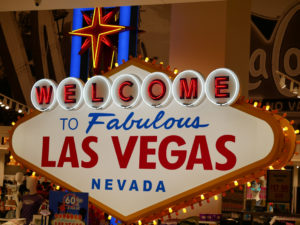
This past weekend we dined our way around Las Vegas seeking out the most allergy-friendly restaurants. We were very excited about the awareness all the restaurants we visited had around food allergies.
It wasn’t that long ago, while working at Walt Disney World and on a benchmarking trip to Las Vegas, most restaurants plain and simply said they could not accommodate food allergies. We visited some of those same restaurants again and were excited to see that they now acknowledge guests with food allergies.
Eating out with food allergies can be all too stressful. Check out our Vegas adventure and our one “outstanding” find, as we save the best for last…
Our first step was to compile a list of questions to ask each restaurant. Check out our post, “7 Questions To Ask That Could Save Your Life When Dining Out”.
Before the trip we contacted many restaurants by phone and email. We like talking to someone on the phone so we can ask specific questions and get a feeling of their knowledge and understanding of food allergies. Once we got to Las Vegas, we also stopped by dozens of restaurants in person.
Let’s get eating, or not!
- Thailicious
A trip to Vegas would not be complete without dining off the strip at Thailicious Authentic Thai & Vegan with our good friends from Hawaii, Dave and Beth who now live in Las Vegas. They are regulars and Beth is extremely allergic to shrimp and has other intolerances. Thailicious serves many guests with food allergies, using clean and sanitized pans for their dishes. Along with their regular menu, they also have a large vegan menu. Their vegan option of the green papaya salad rocks and is better than any non-vegan green papaya salad I can remember, and there are options for the peanuts if they are an issue. I had 2 orders of their veggie fresh rolls…I could eat them all day long! The soups, curries, and appetizers flowed.
Yes, we trust this restaurant to keep us safe!
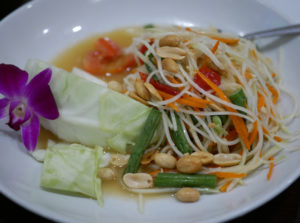
- Carmine’s in the Forum Shops at Caesar’s Palace
We were impressed by the fact that Carmine’s has 4 dietary menus; Dairy & Egg Free, Wheat & Gluten, Vegetarian & Vegan, and Garlic. So impressed, we decided to have lunch. I ordered the Country Style Pasta, gluten-free and without sausage. When I asked the server if a meat stock was used, she said, “We’ll since you don’t want sausage, I would think they wouldn’t put in any stock”. Really??? Joel ordered gluten-free pasta with marinara. When his dish arrived, it was with linguine that was not gluten-free. Can you believe that our server got an attitude about the mix up? Well, besides the bad service, the fact that we were served wheat when it was made clear we had a wheat allergy, and the restaurant’s disclaimer that their “busy” kitchen is not allergen-free is a good reason not to dine here.
- Trevi in the Forum Shops at Caesar’s Palace
After dining at Carmine’s, we came across Trevi, a Landry restaurant. Landry’s Inc. has been a leader in the food allergy industry. We were sorry we didn’t find this spot first. We’ll definitely check them out on our next trip. They have a great gluten-sensitive and vegan menu and will work with your food allergies.
- Gordon Ramsay Pub & Grill at Caesar’s Palace
They work with guests with food allergies and have a gluten-free menu. Their Kale Salad with butternut squash, dried cranberries, and honey mustard vinaigrette was calling. We’ll be back to try it.
- Mesa Grill by Bobby Flay at Caesar’s Palace
The host was just as friendly as she could be. She spent a good 15 minutes going through every menu item to let us know the ingredients in each. There really weren’t any safe options for us here.
- Eataly
There’s a lot of talk about Eataly at Park MGM. I suggest if you have food allergies ignore the hype. We dined at La Pizza & La Pasta. Our server was very attentive and asked about our food allergies. Options were limited with only 2 being gluten-free, low-gluten pizza crust (baked in the same oven as all the pizzas) and gluten-free casarecca pasta. As attentive as he seemed, we ordered Barbabietola (roasted beets & ricotta with a citrus vinaigrette) without the ricotta cheese as we again mentioned our milk allergy. Can you believe that it was delivered to the table with the ricotta cheese? Really???
Eataly is a no-go!
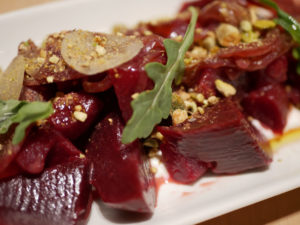
- Julian Serrano at Aria
Joel was craving tapas, so we checked out Julian Serrano at Aria. The host assured us that the servers are trained, and they talk to the chef. They did provide a verbal disclaimer saying they can’t guarantee there is no cross contact. Our allergies were documented. They modified the patatas bravas, which were just okay. If you’re craving patatas bravas, check out our recipe…much better!
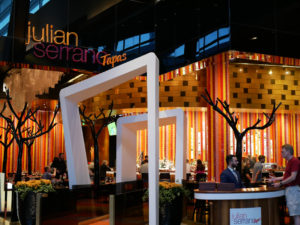
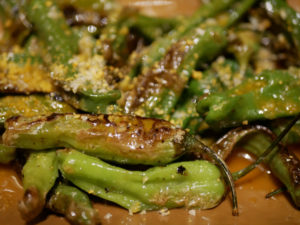
Padron Peppers with a Spicy Orange Glaze
- Herringbone at Aria
The host said they accommodate guests with food allergies most of the time. She shared with us their “Allergy Alert Card”. The card was magenta in color. The 8 allergens listed on their card were gluten, fish, nuts, oats, dairy, eggs, soybean, and shellfish. They have no gluten-free pasta or bread and are limited on soy-free options. We opted not to dine here.
- Border Grill at Mandalay Bay
The dining operator for Mandalay Bay said that allergies require a 24-hour notice to the restaurant. She gave us the direct number for Border Grill. We spoke to the General Manager, Yancy who said they could certainly accommodate us. They will fry chips or fried items in a separate pot with new oil. They change gloves for allergies and use clean and sanitized boards and utensils. He shared that they recently fed 16 kids with food allergies and appeared in their magazine. We give Border Grill a thumbs up!
- Aureole at Mandalay Bay
The host said they absolutely accommodate guests as long as the chef knows. We have dined here before, but on this trip our evening plans were already booked, however we will give Aureole’s another try.
- II Fornaio at the Venetian
The host had to ask the server if they can accommodate food allergies. She was able to find out that servers are required to take training on food allergies. Since the host had no idea if they serve guests with food allergies. We’ll skip it.
- Yardbird Southern Table & Bar at the Venetian
Host advised that the servers and bussers have had training, but they don’t train locally.??? We’ll pass.
- Bouchon at the Venetian
The host said they accommodate guests with any food allergies. The server will let the host know who will let the kitchen and manager know. Reservations made in advance will be notated of the allergy/allergies. Bouchon has always been a favorite of ours.
- Burger Bar at Mandalay Bay
Burger Bar accommodates guests with food allergies and the host said they “tend” to be very careful about them. She shared that there is no specific training for the staff on food allergies.??? Our gut quickly said no!
- Robert Irvine’s Public House at Tropicana Las Vegas
The host said they don’t prepare food for guests with food allergies often. She also said that there is no food allergy training in place. We love that Robert Irvine works out and is into health and wellness, however, we’ll pass.
Saving the Best for Last!
Our Number 1 Choice for dining in Las Vegas with Food Allergies:
- South Point Hotel Casino & Spa

The safest place we found in Las Vegas was South Point Hotel Casino & Spa, thanks to Asst. Executive Chef Keith Norman. Chef Keith is committed to serving guests with food allergies and provides ongoing training to all staff members in every food establishment on property.
Stay at South Point and you need not worry about dining out. Your options are In-Room Dining, Baja Miguel’s, Garden Buffet, Del Mar Deli, Steak ‘n Shake, Don Vito’s, Zenshin Asian Restaurant, Big Sur Oyster Bar, Primarily Prime Rib, Silverado Steak House, Coronado Café, Kate’s Korner Ice Cream Parlor, and Michael’s Gourmet Room. Oh, the movie theatre and bowling alley on property are also onboard to assist guests with food allergies.
You will find this Allergy Awareness card on every podium of every restaurant at South Point. The hosts know just as much about food allergies and the menus as do the servers, bussers, managers, cooks, and chef.
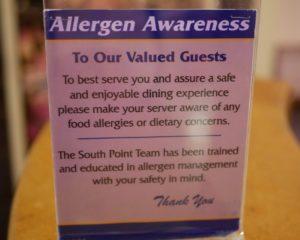
Servers in all restaurants fill out an Allergen Alert slip when taking your order. The allergens are input in their POS (point of sale) system and are printed on the ticket. Your bill also notates your allergies. Not to mention, everyone is notified of your allergies from the host to manager and chef, to the busser and server.
- Big Sur Oyster Bar at South Point
When we ordered our salads, out came the purple cutting board and tools used for food allergies. The cook changed his gloves to new purple gloves. He didn’t grab a bowl from the stack, but had bowls set aside for guests with food allergies that were individually wrapped in plastic.
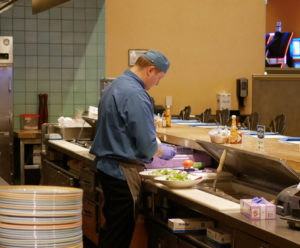
the purple cutting board, gloves, and utensils
- Baja Miguel’s at South Point
Without even asking, Lose (the host) brought us avocado slices to make our own guacamole since their guacamole comes in prepared and contains gluten. They brought special tortilla chips for Joel that were gluten-free. Since the gluten-free chips were fried in soybean oil, they brought me wedges of warm corn tortillas. Lose also said she had the kitchen making special beans for me without the pork lard. Now, we didn’t even ask for any of this.
Our server, Alex gave us several blank “Allergen Alert” cards. He told us we could fill them out and give them to other places we wanted to dine at. Going above and beyond, it is clear that Alex, Lose and the entire culinary team at South Point care about the safety of their guests.
- Garden Buffet at South Point
Oh, yes! We had to check out the buffet. We arrived 40 minutes before the buffet opened to be first in line. The host immediately contacted the chef, who greeted us and walked us through the entire buffet, letting us know about each item and what was safe to eat. The chef also said they can prepare some items safely in the back.
Have you gone to Walt Disney World or Disney Land because you know it’s a safe place for guests with food allergies? Well, plan a trip to Las Vegas and know that South Point has joined the ranks of Disney for food allergen safety!
Chef Joel’s Tips
- When dining out, choose a dish that is prepared to order, with a clean and sanitized pan and cooking utensils. Batch foods like soups or stews that have been cooking for a while have a greater chance of being contaminated by cross contact.
- If your allergy is severe, do not eat at buffets. There’s just too much of a chance for cross contact. However, if you want to dine at South Point’s Garden Buffet, be the first in line when the buffet opens. After walking the line with the chef, be one of the first to get your food. It won’t take long for cross contact issues to occur. A guest drips blue cheese salad dressing into the balsamic vinegar. Another guest uses the spoon for crab salad, and then gets some plain beets with the same spoon, leaving the spoon with crab in the beets. You get the idea, right?
- Even if you’ve done your due diligence and make dining plans, but all of a sudden have a gut feeling of uncertainty, that’s okay. Always listen to your gut.
- Carrying a “chef card” that outlines the foods you must avoid is a great way to communicate your food allergies to a chef or manager at restaurants. FARE provides an interactive PDF of chef card templates in English and a number of foreign languages to use while dining out and traveling.
- It’s always stressed to ask for the manager or chef. That is very important and you need to do that. However, we like to first talk to the host. If the host has no knowledge of the establishment’s allergy policy, we avoid that restaurant. As first point of contact for the guests, we believe the hosts should know the policies.
- The best time to dine at any restaurant is during the first hour of a service period. The staff is more alert and attentive and the kitchen is much cleaner.
The post Dining in Las Vegas with Food Allergies appeared first on Your Allergy Chefs.
]]>The post Food Allergy Questions Left Unanswered Could Kill appeared first on Your Allergy Chefs.
]]>
What a privilege it was to present at the FARECon Featuring Teen Summit earlier this month in Washington, D.C. We had an incredible time talking with parents and teens living with food allergies.
During the adult session, “Behind the Scenes, Tips for Safe Dining,” I asked participants to share their biggest frustrations about dining out and any questions they had. We got some great responses which may resonate with you.
Here’s our best advice in answering your questions and frustrations in the following Q&A with Chef Joel, former Manager of Product Development and Special Diets at Walt Disney World…
7 Questions
Q: Saying I have food allergies doesn’t sound strong enough for exactly what will happen if I eat food I’m allergic to. What else can be said to get my point of severity across to the servers and chefs who don’t even understand the term “anaphylaxis?”
A: An excellent question! To make your point crystal clear, you need to say that you could die if you eat even a trace particle of the allergen.
Q: Can you explain filtration again? Also, are there really any designated fryers in restaurants?
A: Filtration is the act of filtering cooking oil to remove food particles, so the oil lasts longer. The problem with filtration is that the protein molecules that are in the oil are not removed during the process, thus the allergen proteins remain in the oil. Cooking and the high temperatures of the fryer do not destroy the proteins.
Yes, some restaurants can have a designated fryer. However, they have to filter the oil from the designated fryer separately and put it back into the designated fryer without commingling with the common fryer oil. A mistake is made when an establishment has 2 fryers that share the same oil. They may designate one side for frying foods that are allergen free, but cross contact occurs because of the shared oil.
Q: A restaurant lists gluten free items with a red “GF” symbol and the asterisk on the menu says, “gluten friendly.” What does that mean?
A: Gluten friendly can mean 2 things. (1) A dish that is naturally gluten free, such as chicken or rice. (2) No gluten was added to the dish. By saying gluten friendly, the establishment is not guaranteeing the item is gluten free and free from cross contact. In a nutshell, the establishment is not taking any liability for cross contact, which happens when an allergen is accidentally transferred from one food to another.
Q: How do you deal with objections of restaurant owners in setting up allergy safe processes?
A: No deal. Don’t eat there. Appreciate their honesty. It’s better to know that they are unwilling to help than to half-ass try to accommodate you and make a mistake.
Q: Why can Disney manage food allergies so well and other food service operations cannot?
A: The culture of Disney is to make magic for every guest. It’s a huge commitment that they have made. It’s about training, processes, menus, and ingredients. They start with training, which is ongoing. They follow processes, modify menus, and source special products to make serving people with food allergies easy.
Q: What national chains have the best food allergy procedures?
A: The leading guide to allergy friendly restaurants nationwide is AllergyEats. Check out their website to find the restaurants in your area that are ready and willing to accommodate your allergies…and find those that aren’t.
Q: When we buy food at a grocery store, we don’t buy foods that say, “made on shared equipment.” When we call a restaurant and they say “we don’t serve anything with peanuts, how likely is that true and do you think they are looking for or are even aware of cross contact in products?
A: It is likely the restaurant doesn’t serve anything containing peanuts. However, there is always the possibility of cross contact. It is very likely they don’t understand cross contact. After advising the chef or manager of your allergy, you need to make sure you are able to see all ingredient labels to ensure the ingredients they use are not made on shared equipment.
It may be hard to see all of the ingredient labels. Many items are received in boxes where the ingredient label is on the outside of the box which gets broken down and recycled. But, if the establishment is committed to serving people with food allergies, this label would have been removed from the outer box and put in a recipe ingredient binder or other such practice. It’s also important to know if the binder is updated when there are ingredient changes from the manufacturer.
7 Frustrations
- When different people at the restaurant give different answers for the same questions.
- When the restaurant staff think an allergy means gluten free.
- When restaurant staff are not being trained on food allergies.
- Apathy from restaurant staff about food allergies, i.e. eyes rolling, lack of action, not letting kitchen staff know of my allergy.
- Servers not knowing what ingredients are in their restaurant’s food.
- When our family eats out, the waitstaff respond to our allergy ingredient questions with “that should be fine” or “I don’t think those ingredients are in that.”
- Restaurant staff not taking our food allergy requests seriously, i.e. taking a burger off the bun that my son is allergic to and giving the same burger back to him.
Chef Joel’s Advice
These 7 frustrations are all too familiar. They are all signs of restaurants not committed to serving guests with food allergies.
Only eat at restaurants that are 100% committed!
Most important, don’t be afraid to ask questions. After all, no question is a bad question for those living with food allergies.
Check out our post, 7 Questions To Ask That Could Save Your Life When Dining Out for additional tips.
Stay tuned for more of the questions from the FARECon Featuring Teen Summit in the upcoming section of the website, “Ask Chef Joel.”

The post Food Allergy Questions Left Unanswered Could Kill appeared first on Your Allergy Chefs.
]]>The post 7 Questions To Ask That Could Save Your Life When Dining Out appeared first on Your Allergy Chefs.
]]>
While working at Walt Disney World Resort as Manager of Product Development and Special Diets, I encountered many families of children with food allergies and intolerances, and learned from them the challenges they face.
If preparing food at home isn’t challenging enough, dining out is a daunting task. At least at home, you have control over what you purchase and how it’s prepared – but when dining out, you are in the hands of the restaurant staff.
Before choosing a restaurant, pick a cuisine that suits your special diet. If you’re sensitive to gluten and dairy, you may want to steer clear from Italian restaurants. Chinese cuisine is too dangerous a choice for those at risk of anaphylaxis due to peanut, nut, sesame or shellfish allergies. These are staples in Chinese cuisine, so the risks of cross-contact and mistakes in the kitchen are high.
After choosing a restaurant, call ahead and ask to speak with the chef or manager. If the chef or manager isn’t available, ask for a name and the best time to call back.
When you talk with the chef or manager, ask these 7 questions. Your life could depend on it.
1. Are you willing to accommodate my special diet?
If the answer is yes, provide more information about your food allergies. Make sure they understand the severity of your allergies or intolerances.
2. Do you have a food allergy policy and training in place?
How often do you train your staff? This is important because there is constant employee turnover in the food service industry. You don’t want a new employee who hasn’t been properly trained handling your dietary request.
3. Do you prepare foods for customers with food allergies often?
If the restaurant is not used to serving customers with food allergies, think twice before dining there.
4. Do you have a separate area to prepare foods for special diets?
Ask whether separate cutting boards and utensils are used for preparing meals for special diets. Do they have separate cooking equipment such as fryers, toasters, and saute pans?
5. May I review your recipe book or ingredient list?

A recipe book is common in most, if not all kitchens. These books are often updated when recipes are changed so the information is usually accurate. Be on the alert for hidden ingredients. Ask to review the labels of any commercially prepared sauces that might be used in meal preparation. As a rule, it’s best to order simply seasoned meats and vegetables.
6. How will the meal be prepared and cooked?
Let the chef know what you or your child usually eats. This will make it easier for them to provide you with a safe choice. Ask them to explain how they will prepare and cook the meal – this will clue you into whether or not they “get it”. Don’t eat at a restaurant unless you’re sure the chef or manager understands your request.
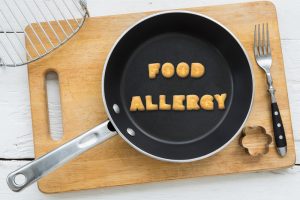
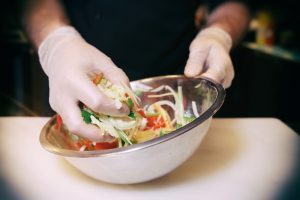
7. Will you be at the restaurant when I arrive?
You don’t want to take a chance that information may be passed on to someone else incorrectly. When you arrive at the restaurant, it’s best to talk to the same chef or manager you spoke to on the phone. Plan on having an early meal. The best time to dine at any restaurant is during the first hour of a service period. The staff is more alert and attentive and the kitchen is much cleaner.

In closing, if you do your research, talk to a chef or manager about your dietary request before arriving, communicate your needs with the staff at the restaurant and review your meal before taking your first bite, you and your family should have a magical dining experience.
Bon appetit!
The post 7 Questions To Ask That Could Save Your Life When Dining Out appeared first on Your Allergy Chefs.
]]>The post Are Restaurants Killing Innocent Patrons? appeared first on Your Allergy Chefs.
]]>
Are restaurants to blame for so many reported deaths of patrons with food allergies? This is a question that continues to draw attention in the news today. We did some digging to find the facts and along with our knowledge and experience in the food service industry share our opinion on this subject.
Nearly half of reported fatal food allergy reactions over a 13-year period were caused by food from a restaurant or other food service establishment. (1)
Centers for Disease Control and Prevention’s Disturbing Report
The CDC (Centers for Disease Control and Prevention) Environmental Health Specialists Network conducted an interview with restaurants. They found that most of the 278 restaurants they interviewed did not follow practices that minimize cross-contact or accidental ingestion of food allergens.
The restaurants interviewed were in California, New York, including New York City, Minnesota, Rhode Island, and Tennessee. Managers of these restaurants reported this disturbing information about their own restaurants:
- 78% have no dedicated set of utensils or equipment in restaurant for preparing allergen-free meals.
- 92.4% reported having no special area in the kitchen for preparing allergen-free food.
- Only 10.3% have a special fryer designated for cooking allergen-free food.
- Only 7.2% have a special pick-up area for customers with food allergies.
- Less than half of the surveyed restaurants do not provide food allergy training for their staffs, and the training provided often does not cover important information such as what to do if a customer has an allergic reaction (e.g., difficulty breathing). Food Allergy Research & Education (FARE) guidance stresses the importance of staff members responding appropriately to allergic reactions. (2)
Brace Yourself for These Startling Report Findings
- First, because the interview responses were self-reported, they are subject to social desirability bias, which might have resulted in over reporting of appropriate practices.
- Second, because interviewed food workers and servers were selected by managers, and not at random, their responses might not represent the experiences or practices of all food workers and servers.
- Third, because the data were collected from English-speaking staff members only, they might not reflect practices in restaurants where no one speaks English.
- Finally, the low response rate (32.6%) might have resulted in an overrepresentation of restaurants with better food allergy practices. (3)
Are Chefs to Blame?
It’s shocking how many food service professionals do not know the difference between cross-contamination and cross-contact.
Last week we talked to a group of chefs and servers who had no idea what cross-contact was. Most chefs only get training on cross-contamination. For this reason, are the chefs to blame?
Moreover, what is this cross-contact and how does it differ from cross-contamination?
Cross-Contact

Cross-contact between foods with allergen and those without
Cross-contact is the transference of proteins. This occurs when an allergen is inadvertently transferred from a food containing an allergen to a food that does not contain the allergen.
The truth is, cooking does not reduce or eliminate the chances of a person with a food allergy having a reaction to the food eaten. This can happen when utensils, pots, pans, or hands are not properly washed and sanitized between food preparations.
In the example above, cross-contact is likely to occur. The knife with peanut butter and the shrimp are both major allergens on the same cutting board with ready to eat food.
Cross-Contamination
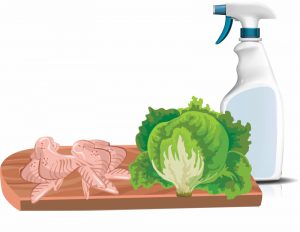 Cross-contamination is the transference of bacteria and is a common factor in the cause of foodborne illness. Microorganisms such as bacteria and viruses from different sources can contaminate foods during preparation and storage.
Cross-contamination is the transference of bacteria and is a common factor in the cause of foodborne illness. Microorganisms such as bacteria and viruses from different sources can contaminate foods during preparation and storage.
However, proper cooking of the contaminated food in most cases will reduce or eliminate the chances of a foodborne illness. (4)
In this example, chemicals from the spray bottle and raw chicken are contaminants for the ready to eat lettuce.
Katelyn’s Heartbreaking Story
A 13-year old Chicago girl suffered a fatal anaphylactic reaction after eating Chinese food at a school Christmas party. The food was supposed to be safe.
Katelyn Carlson, who was allergic to peanuts, was rushed to the hospital in the early afternoon, but died a few hours later. An autopsy confirmed that her death was caused by anaphylaxis, the serious and swift-progressing form of allergic reaction.
The teacher had checked several times with the restaurant to make sure that the food being prepared would be safe. What happened? The food was tested by the medical examiner’s office and the University of Nebraska. Horribly, the results showed that the food was “heavily contaminated with peanut products and that this was the tragic cause of this child’s death.”
“Katelyn’s death is tragic and devastating to her parents and her classmates – and frankly to all of us who are at risk of anaphylaxis, or have a child at risk,” says Gwen Smith, editor of Allergic Living magazine. Gwen says that Chinese cuisine, except if made at home or by a chef highly trained on allergy management, is too dangerous a choice for those at risk of anaphylaxis due to peanut, nut, sesame or shellfish allergies. These are staples in the cuisine, so the risks of cross-contact or mistakes in such a restaurant kitchen are always high.
Gwen urgently reminds people with allergies to take extra care when they are eating foods prepared by others and to always use an auto-injector (EpiPen) at the first sign of a serious reaction. In too many of the fatalities, epinephrine is used late or not at all. In case of doubt, please use your auto-injector. (5)
We thank Allergic Living for permission to share Katelyn’s story, in hopes that we can one day prevent this from happening to others.
The FDA’s Failure to Govern Restaurants
I called the FDA in June only to confirm something I already knew. They don’t govern restaurants. Strangely enough, food allergy training is left up to each state and varies from state to state.
Having recently moved to California, I decided to investigate their stand on food allergies. I called Los Angeles County Public Health and spoke to a representative who was an absolute angel with compassion for those with food allergies and special diets. She gave me some contacts.
I reached out to the Sacramento County Public Law Library. They shared, “For the most part, state legislators and their respective state restaurant associations have not been able to come to any conclusive agreements on the role restaurants could or should play in regard to food allergy safety.
Currently, California has not passed any statutes or regulations that require restaurants to publish dish ingredients or warn customers about possible allergens, though restaurants can, and frequently do, include warnings of their volition.”
Several weeks after writing this post, I got an emotional email from the angel I told you about. She shared the news of code SB 1067 that was enforced in California in July. The code requires the person in charge of the retail food facility and all food employees to have adequate knowledge of major food allergens and the symptoms that a major food allergen could cause in an individual with food allergies. Finally! I am so excited to be able to add this thrilling update before posting.
The Fabulous Five
Did you know that five states have enacted laws to make it safer for those with food allergies to dine at restaurants? Those fabulous five are Massachusetts, Maryland, Michigan, Rhode Island and Virginia. It’s time for all states to join in. Lives are at risk and many have already been lost.
Remembering Those We Have Lost
We have had 10 food allergy deaths so far this year, with 4 related to food service establishments.
- Megan Lee was 15 years old and died on January 1 after a severe allergic reaction to takeaway food in Lancashire, England.
- This past March, 23-year old Anthony Maruca was in the Boston area starting a new job after graduating from college, where he died after ingesting an allergen while eating at a local restaurant.
- Nissan Hayuni, 32 years old, was travelling to the U.S. with his wife on their honeymoon in May. Nissan died onboard Iberia Airlines shortly after eating a specially ordered Kosher meal.
- Most recently making news was the death of 3-year old Alastair Watson. Alastair had multiple food allergies, including dairy. At the Children’s Hospital of Alabama in Birmingham, Alastair was taking part in an oral challenge test to see whether he could tolerate food that contained baked milk. He could not and he died on July 30.
Please visit No Nuts Moms Group to see all the wonderful things they’re doing and to remember the many others we have lost to food allergies.
Beyond the Restaurants’ Responsibilities
In our professional opinion, the point is clear that there is a responsibility for food service operations to provide proper training on food allergen safety.
They need to be able to communicate menu ingredients to their guests. They have to be knowledgeable about what food allergies they are capable of managing and what menu items they are not able to accommodate. For this to happen, we need to fight to have laws in place beyond what is provided in the FDA Food Code. To help move this along, getting involved and supporting FARE in their initiatives will only make our own efforts more effective.
Where does the responsibility lie for keeping guests with food allergies and special diets safe? In our opinion, it takes more than just one person or organization.
There is no doubt that laws must be enacted to make it safer for those with food allergies to dine at restaurants. That’s a given! But all restaurants need to take this seriously. If they don’t feel they can handle serving guests with food allergies, they need to be open and honest in their communication.
And chefs need to keep up with the times. The dining scene is different now than ever before with so many people with food allergies and special diets.
At the same time, those of us living with food allergies and special diets have got to do our part. Like Gwen Smith, editor of Allergic Living, urgently said to those with allergies to take extra care when eating food prepared by others and always use an EpiPen at the first sign of a serious reaction.
What do you think? We’d love to hear your thoughts.
In closing, we would like to thank FARE who works on behalf of the 15 million Americans with food allergies, including all those at risk for life-threatening anaphylaxis. This potentially deadly disease affects 1 in 13 children in the United States – or roughly two in every classroom. What if your child or grandchild was in the 1 in 13? Or maybe he or she is.
References
_________________
- Weiss, C, Munoz-Furlong A. Fatal food allergy reactions in restaurants and food-service establishments: strategies for prevention. Food Prot Trends 2008;28:657-61
- FARE (Food Allergy Research & Education). Welcoming guests with food allergies. McLean, VA: Food Allergy Research & Education; 2014.
- Corresponding author: Taylor J. Radke, tradke@cdc.gov:
- Schaefer, J: Serving People with Food Allergies, Kitchen Management and Menu Creation: CRC Press 2011
- Gwen Smith, Editor of Allergic Living. www.allergicliving.com
The post Are Restaurants Killing Innocent Patrons? appeared first on Your Allergy Chefs.
]]>